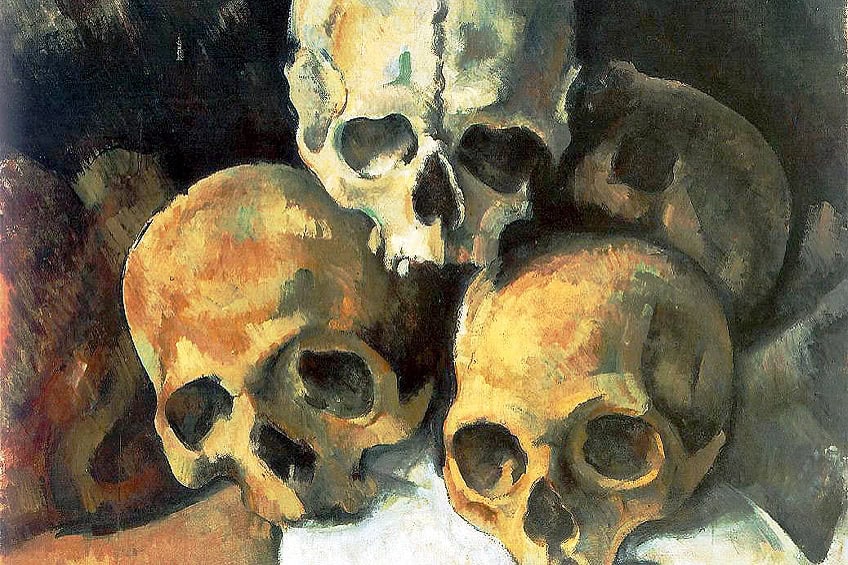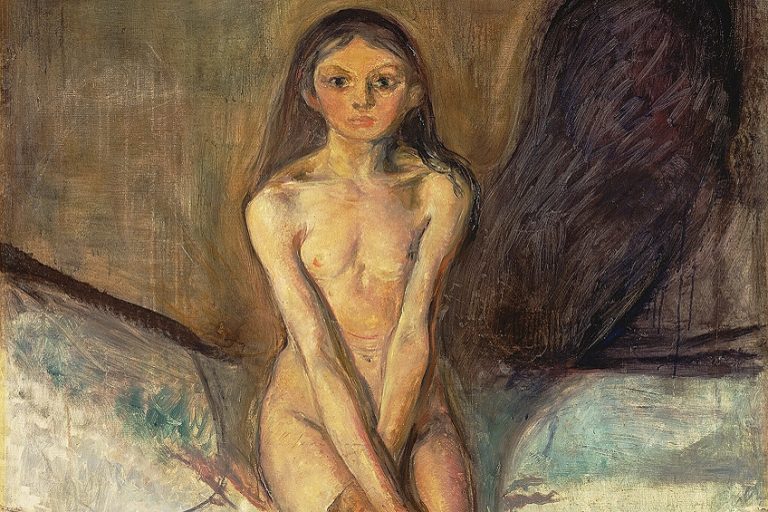“Pyramid of Skulls” by Paul Cézanne – The Art of Death
Paul Cézanne’s Pyramid of Skulls, painted between 1901 and 1902, is a haunting still life that showcases the artist’s fascination with mortality and the transience of life. This compelling work features a stark arrangement of four human skulls, carefully balanced in a pyramid formation against a dark, shadowy background. The composition reflects Cézanne’s meticulous attention to form and structure, emphasizing his deep engagement with the themes of death and decay. Pyramid of Skulls is a powerful meditation on the inevitability of death, illustrating Cézanne’s skill in transforming a simple subject into a profound and contemplative piece of art.
Key Takeaways
- Pyramid of Skulls is an oil painting by Paul Cézanne from around 1901.
- The painting reflects Cézanne’s focus on themes of mortality.
- It highlights Cézanne’s artistic impact and continued relevance.
Historical Context
| Artist | Paul Cézanne (1839 – 1906) |
| Date Created | c. 1901 |
| Medium | Oil on canvas |
| Genre | Still Life |
| Period/Movement | Post-Impressionism |
| Dimensions (cm) | 37 x 45.5 |
| Series/Versions | None |
| Where Is It Housed? | Private collection (formerly part of the collection at the Kunstmuseum Basel, Switzerland) |
| What It Is Worth | Estimated at $25-30 million (value based on recent market trends) |
Paul Cézanne’s Pyramid of Skulls is an intriguing example of post-impressionist art that captivates both the casual viewer and the seasoned art lover. Created around 1901 in his studio in Aix, France, this small oil on canvas painting measures 37 by 45.5 cm. It depicts four human skulls arranged in a pyramidal formation, a subject that preoccupied Cézanne during his later years. This striking composition invites deep reflection on themes of mortality, making it a powerful piece in his extensive body of work. Cézanne’s approach in Pyramid of Skulls sheds light on his unique perspective in the world of art.
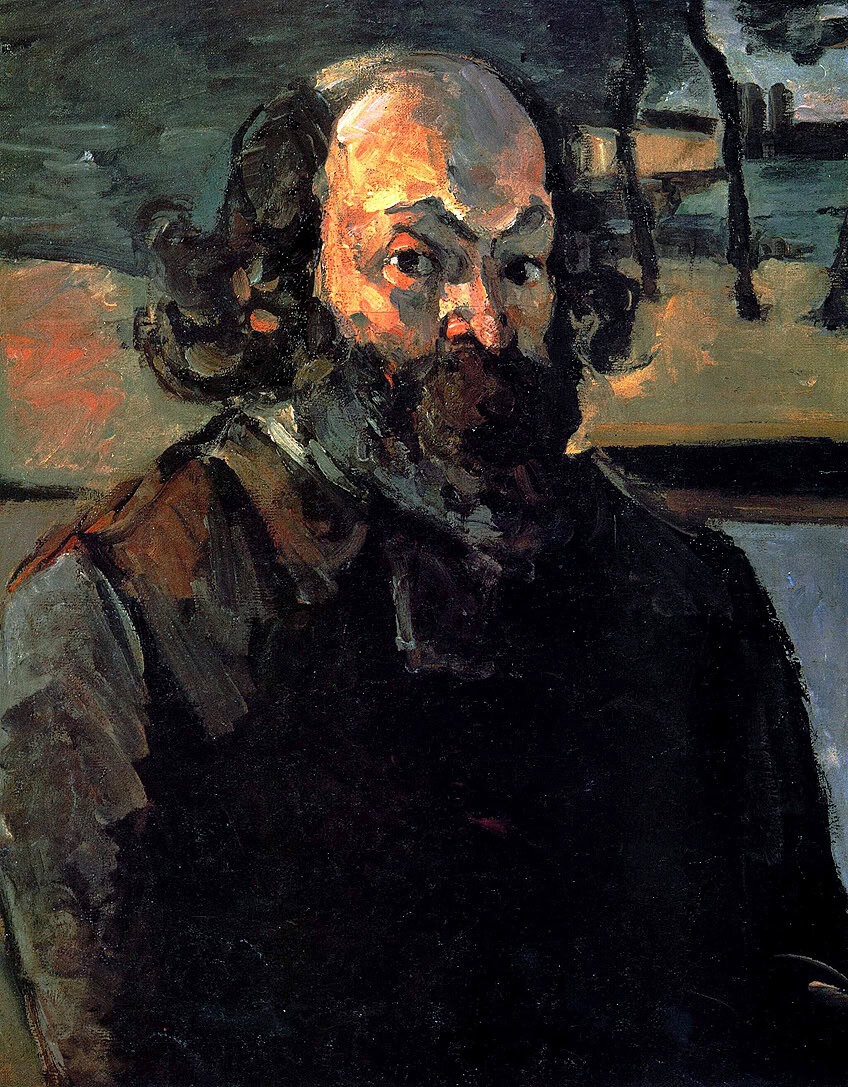
His focus on still-life compositions, especially those involving skulls, represents a shift in his artistic vision driven by personal introspection. The painting’s stark, almost unsettling imagery stands out amid his other works, providing insight into his thoughts and emotions during this period. The painting resides in a private collection and remains a point of fascination for art historians and enthusiasts. Its simplicity combined with profound symbolic depth showcases Cézanne’s mastery and lasting influence in the art world. This work not only highlights his technical skill but also his ability to engage viewers in contemplating life’s deeper questions.
Influence of Mortality
By 1901, Paul Cézanne was increasingly preoccupied with themes of death and the passage of time. This focus is evident in Pyramid of Skulls, which features four human skulls stacked in a pyramidal formation. Cézanne’s contemplation of mortality was influenced by his advancing age and declining health. The skulls, depicted in a stark light against a dark background, underline this preoccupation, as does the eerie closeness of the objects to the viewer. His letters to friends, including Joachim Gasquet, reveal his ruminations on these themes.
Some art historians, like Françoise Cachin, suggest that this focus emerged from a deeper, philosophical inquiry into existence itself.
Late Period and Les Lauves Studio
During the last decade of his life, Cézanne worked primarily in his studio at Les Lauves in Aix-en-Provence. This period marked a phase of intense isolation and concentration on his craft. The Les Lauves Studio provided Cézanne an environment to explore complex themes and compositions. It is in this studio that Pyramid of Skulls was created. This work is notable for the meticulous attention to detail and the raw emotional depth it conveys.

Cézanne’s late period saw a shift towards more introspective and somber subjects, as he distanced himself from public exhibitions and focused on his internal world. This change is prominently reflected in the eerie and contemplative nature of Pyramid of Skulls.
Analyzing Pyramid of Skulls
Pyramid of Skulls is a significant work by Paul Cézanne, providing a deep reflection on mortality through its depiction of human skulls. This painting is notable for its symbolic content, composition, and use of color.
Subject Matter and Symbolism
Cézanne’s Pyramid of Skulls features four human skulls arranged in a pyramid. This configuration underscores themes of death and the fleeting nature of life, aligning with the vanitas tradition in still-life paintings. Vanitas paintings are meant to remind viewers of the inevitability of death. The use of skulls highlights human mortality, making the viewer confront the reality of life’s end. This focus on death is a key aspect of Cézanne’s later works.
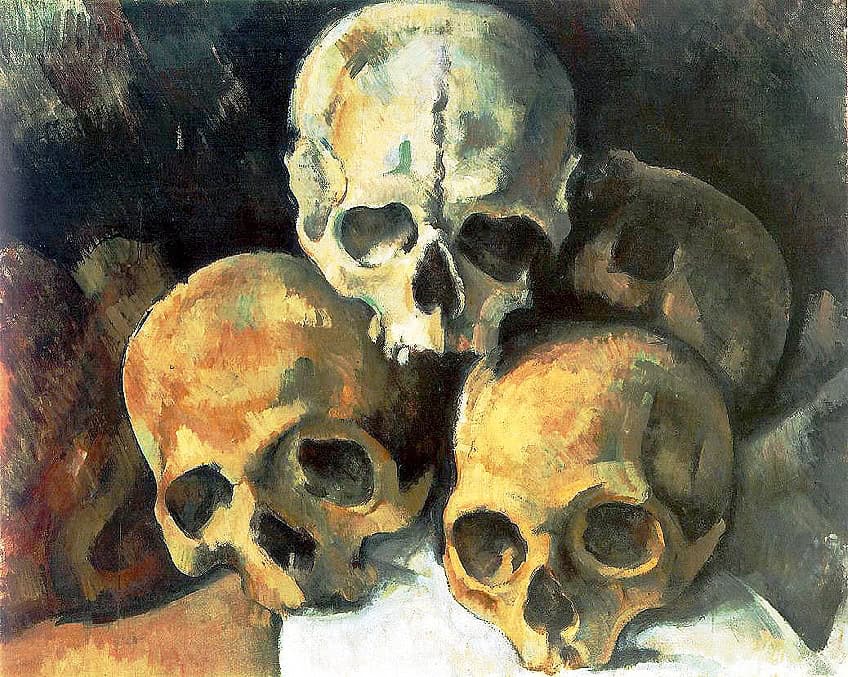
Composition and Technique
The composition of Pyramid of Skulls draws the viewer’s eye directly to the skulls. By placing the skulls in a pyramidal formation, Cézanne creates a strong, stable structure that anchors the painting. Cézanne employs a meticulous technique that brings out the volumetric forms of the skulls. The placement of these forms close to the picture plane makes the viewer feel as if they are in direct confrontation with mortality.
This arrangement is unique in Cézanne’s oeuvre.
Color and Form
The color palette in Pyramid of Skulls is limited, which emphasizes the somber mood of the painting. The pale light cast on the skulls against a dark background adds to this effect, creating a stark contrast that highlights their shapes. Cézanne’s use of color also contributes to the volumetric qualities of the skulls. Through careful shading and light, he gives the skulls a three-dimensional appearance. This approach enhances the realism of the painting and reinforces the theme of mortality.
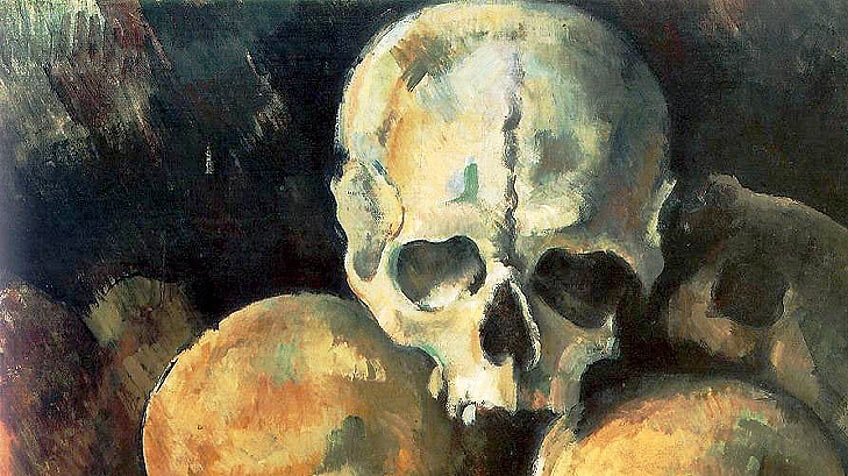
Interpreting the Artwork
Pyramid of Skulls by Paul Cézanne channels deep reflections on mortality and the human condition through its arrangement and subject matter. The painting’s impact is profound because of its close framing and stark presentation.
Viewer Perception
Cézanne’s Pyramid of Skulls is notable for how it affects the viewer. The stark, tightly framed composition of four skulls stacked in a pyramid forces an immediate, almost confrontational interaction. The skulls are painted in pale light against a dark background. This contrast highlights their features and emphasizes their eerie presence. The viewer is drawn into the artwork, experiencing a personal reflection on mortality. The lack of bright colors or distracting details focuses attention on the skulls.
Each skull is uniquely rendered despite the limited color palette, making the viewer ponder the individual lives behind each one.
Theological and Philosophical Contexts
The painting ties into deeper theological and philosophical themes. During Cézanne’s time, still life paintings often contained memento mori elements, reminding viewers of the inevitability of death. Cézanne’s Catholic background might inform some of these themes. Skulls in religious art have historically symbolized contemplation of death and resurrection.

Ancient Christian texts also reference the vanity of earthly life, a theme reflected in the barren presentation. Furthermore, by placing the skulls so close to the viewer, Cézanne seems to ask a philosophical question about human existence. The deathly monotonous arrangement could be seen as a meditation on the sameness of death, stripping away the superficial differences that usually separate individuals in life.
Cézanne’s Influence and Legacy
Paul Cézanne’s work, including Pyramid of Skulls, left a lasting impact on the development of modern art. His innovative approach to form, color, and perspective has influenced many artists and movements.
Impact on Modern Art
Paul Cézanne’s experimentation with geometric forms and structured brushstrokes paved the way for modern art. His unique approach to perspective and color influenced artists like Pablo Picasso and Andy Warhol. Cézanne’s work broke away from traditional techniques and contributed to the development of Cubism. Picasso, in particular, admired Cézanne’s method of breaking down objects into geometric shapes, which became fundamental to Cubism.

Cézanne’s still-life tableaux and bold use of contrast also inspired the Fauvism and Expressionism movements. His ability to convey depth and texture in his oil paintings was revolutionary and continues to be studied in art history classes globally.
Collections and Recognition
Paul Cézanne’s paintings, including Pyramid of Skulls, are held in high esteem by museums and collectors. The Art Institute of Chicago and many other renowned institutions house his works. These collections highlight Cézanne’s role as a key figure in the transition from 19th-century artistic conventions to 20th-century avant-garde movements.
Cézanne’s pieces frequently feature in major retrospectives, emphasizing his lasting influence.
His innovative techniques and visionary approach keep scholars, artists, and art lovers captivated, ensuring his recognition remains robust. Private collectors also seek his works, which command high prices at auctions, further illustrating the significance of his contributions to the art world.
Legacy of Pyramid of Skulls Today
Pyramid of Skulls holds an essential place in Cézanne’s legacy. This work embodies his deepening preoccupation with mortality and the human condition in his later years. The painting’s dark background and close-up placement of the skulls create a stark contrast that underscores the theme of vanitas—a reflection on the transience of life.
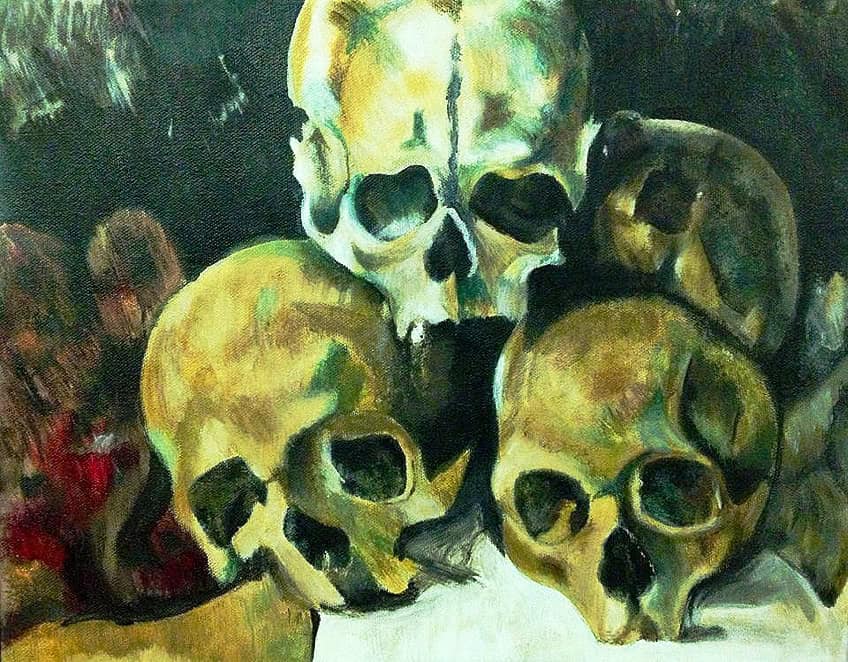
Today, Pyramid of Skulls is celebrated not just for its technical mastery, but also for its emotional depth. Exhibited in various esteemed museums and private collections, the painting continues to provoke thought and inspire contemporary artists. The piece remains a testament to Cézanne’s ability to infuse traditional subjects with modern sensibilities, ensuring his enduring relevance in the world of art.
Pyramid of Skulls stands as a poignant testament to the artist’s exploration of mortality and the human condition. Through his masterful use of composition, light, and form, Cézanne transforms the somber subject of skulls into a deeply evocative and introspective piece. The painting not only highlights Cézanne’s technical prowess but also invites viewers to reflect on the fleeting nature of life. Pyramid of Skulls remains a significant work in Cézanne’s oeuvre, encapsulating his ability to infuse still life with profound philosophical and existential meaning.
Frequently Asked Questions
What Is the Symbolic Interpretation of Pyramid of Skulls?
Pyramid of Skulls is often seen as a memento mori, a reminder of mortality. The stacked skulls create a pyramid shape, suggesting both stability and the inevitability of death. This theme became more prominent in Cézanne’s work in his later years, possibly reflecting his own thoughts on mortality.
How Does Pyramid of Skulls Compare to Other Still-Life Works by Paul Cézanne?
While Cézanne is well-known for his still-life paintings of fruits and everyday objects, Pyramid of Skulls stands out for its stark subject matter and somber tone. Unlike his more colorful and lively compositions, this painting focuses on death and decay, using a muted color palette.
What Artistic Techniques Did Paul Cézanne Use in Pyramid of Skulls?
Cézanne used oil on canvas for Pyramid of Skulls, applying his distinctive brushstrokes to create texture and depth. He placed the skulls close to the viewer, enhancing their impact. The light and shadow in the painting emphasize the three-dimensionality of the skulls, highlighting their form and structure.
How Has Pyramid of Skulls Influenced Modern Art?
Pyramid of Skulls has influenced modern artists by demonstrating the power of still life to convey profound themes. Cézanne’s focus on structure and form over detail inspired later movements, including Cubism. The stark representation of mortality continues to resonate with contemporary artists exploring similar themes.
Isabella studied at the University of Cape Town in South Africa and graduated with a Bachelor of Arts majoring in English Literature & Language and Psychology. Throughout her undergraduate years, she took Art History as an additional subject and absolutely loved it. Building on from her art history knowledge that began in high school, art has always been a particular area of fascination for her. From learning about artworks previously unknown to her, or sharpening her existing understanding of specific works, the ability to continue learning within this interesting sphere excites her greatly.
Her focal points of interest in art history encompass profiling specific artists and art movements, as it is these areas where she is able to really dig deep into the rich narrative of the art world. Additionally, she particularly enjoys exploring the different artistic styles of the 20th century, as well as the important impact that female artists have had on the development of art history.
Learn more about Isabella Meyer and the Art in Context Team.
Cite this Article
Isabella, Meyer, ““Pyramid of Skulls” by Paul Cézanne – The Art of Death.” Art in Context. June 7, 2024. URL: https://artincontext.org/pyramid-of-skulls-by-paul-cezanne/
Meyer, I. (2024, 7 June). “Pyramid of Skulls” by Paul Cézanne – The Art of Death. Art in Context. https://artincontext.org/pyramid-of-skulls-by-paul-cezanne/
Meyer, Isabella. ““Pyramid of Skulls” by Paul Cézanne – The Art of Death.” Art in Context, June 7, 2024. https://artincontext.org/pyramid-of-skulls-by-paul-cezanne/.


